Xylophanes chiron chiron
Xylophanes chiron
zail-AH-fan-eesM KYE-ron
(Drury, 1771) Sphinx
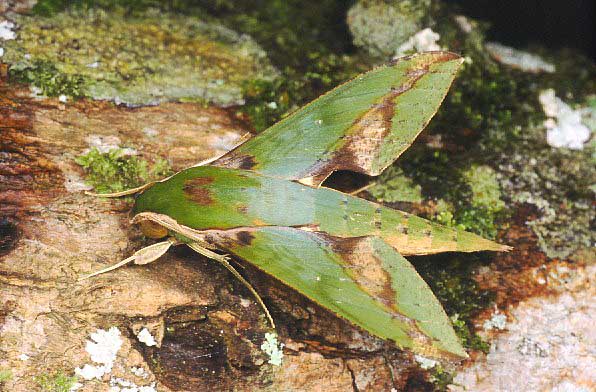
Xylophanes chiron nechus courtesy of Paolo Mazzei,
Rancho Grande, H. Pittier National Park, Venezuela.
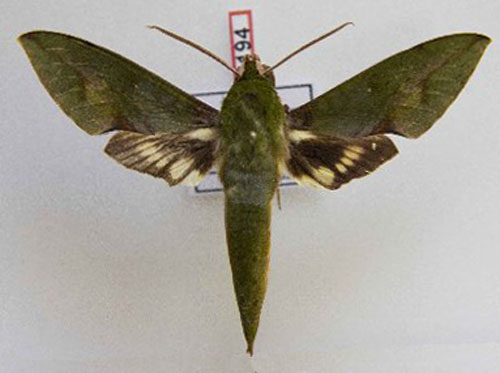
Xylophanes chiron chiron, Jamaica, courtesy of Thomas Melichar.
This site has been created by Bill Oehlke.
Comments, suggestions and/or additional information are welcomed by Bill.
TAXONOMY:
Family: Sphingidae, Latreille, 1802
Subfamily: Macroglossinae, Harris, 1839
Tribe: Macroglossini, Harris, 1839
Genus: Xylophanes Hubner [1819] ...........
Species: chiron chiron (Drury, 1771)
|
DISTRIBUTION: Xylophanes chiron subspecies
[wingspan: 77 - 81 mm] fly from Mexico to Ecuador to northern Argentina: Tucuman, Misiones, Buenos Aires.
Jamaica is the specimen type locality, and apparently the restricted range of
the indigenous nominative subspecies.
Sphinx sagittata Goeze, 1780, Jamaica, is the same as Xylophanes chiron chiron .
Sphinx butus Fabricius, 1787, Jamaica, is the same as Xylophanes chiron chiron
Choerocampa druryi Boisduval, [1875], Jamaica, is same as
Xylophanes chiron nechus . Xylophanes chiron nechus
in resting pose, Yasuni, Ecuador, September 7, 2002 - 12:01 AM, courtesy of Steve Graser. |
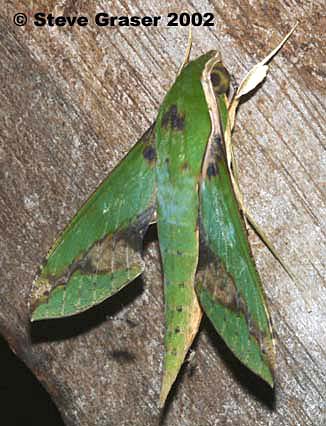 |
The nominate subspecies, Xylophanes chiron chiron, is only depicted in the Thomas Melichar image.
In that subspecies the light brown patches near the costa and anal angle of the fore wing are greatly reduced or absent.
CATE: "Base of forewing with a small black patch that has a pale central; base of inner margin with a patch of primrose-yellow scales;
transverse lines weakly developed; fourth postmedian line edged in pale brown, expanded at the apex into a small triangular patch and towards the inner margin
(below M2) into a narrowly elongate triangular patch (conspicuous in the green form, these pattern elements are difficult to distinguish from the ground
colour in the brown form); a dark brown patch on the inner margin basal to the fourth postmedian line.
Ground colour of hindwing upperside dark brown or black; median band composed of a series of primrose yellow spots."

Xylophanes chiron nechus, Misahualli, Napo, Ecuador, March 3-4, 2009, courtesy of Steve Ife.
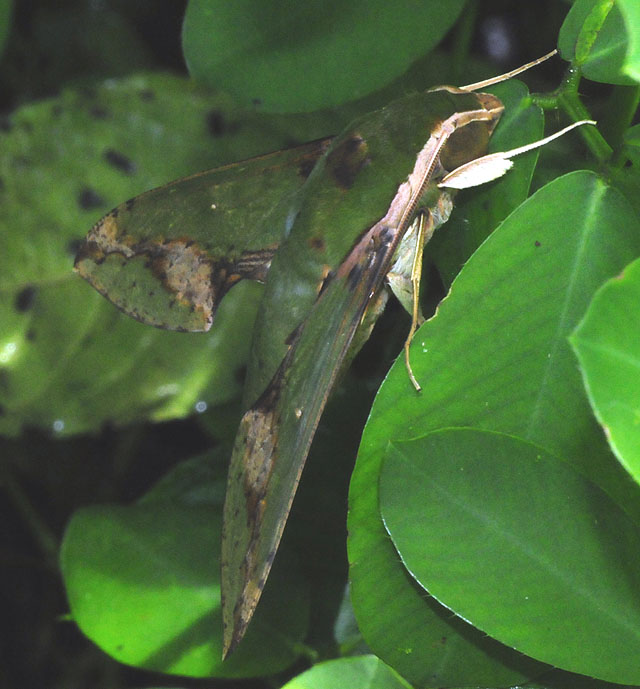
Xylophanes chiron nechus, Misahualli, Napo, Ecuador, March 3-4, 2009, courtesy of Steve Ife.
The pronunciation of scientific names is troublesome for many. The "suggestion" at the top of the page is
merely a suggestion. It is based on commonly accepted English pronunciation of Greek names and/or some
fairly well accepted "rules" for latinized scientific names.
The suggested pronunciations, on this page and on other pages, are primarily put forward to assist those who hear with internal ears as they read.
There are many collectors from different countries whose intonations and accents would be different.
Jean Marie Cadiou writes, "When I say "Xylophanes" in English I pronounce it something like "Zailophanees", with the emphasis on the
"o". The French pronounce it differently, something like "Kzeelophaness" with no emphasis, and the Germans yet in a different way..."
In Greek myth, Phanes is the golden winged Primordial Being who was hatched from the shining Cosmic Egg that was the source of the
universe. He personifies light emerging from chaos.
"Xylo" is the Greek word for wood.
The specimen type for the genus Xylophanes is Xylophanes anubus. Perhaps ? when Hubner
examined this species, the yellow-orange and brown tones of the forewings suggested wings of wood.
The species name "chiron" comes from Greek mythology where Chiron is the wise centaur who tutors Achilles, Hercules and Asclepius.
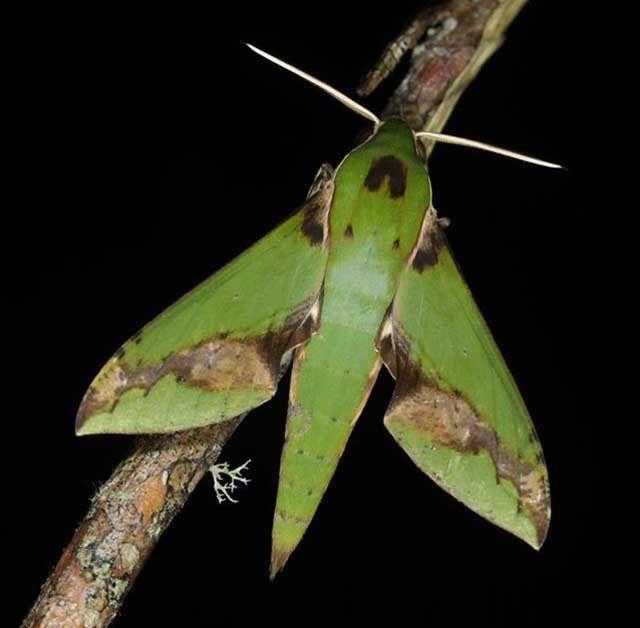
Xylophanes chiron nechus??, Dominican Republic,
courtesy of Jean Haxaire.
FLIGHT TIMES:
Xylophanes chiron has been
recorded on the wing in every month in Costa Rica. There are at least three broods in Peru: January-February, June-July, and October. I have seen images of
subspecies nechus from Merida, Venezuela, in mid January.
ECLOSION:
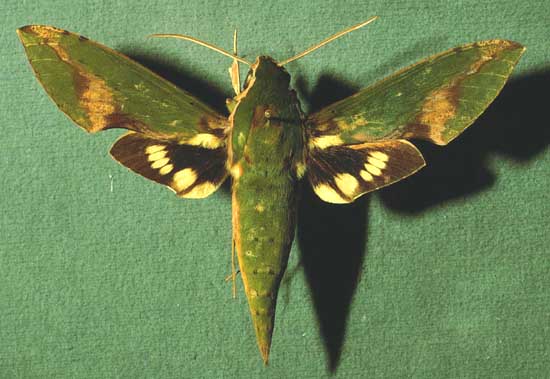
Xylophanes chiron nechus male courtesy of Dan Janzen.
SCENTING AND MATING:Females call in the males with a pheromone released from a gland at the tip of
the abdomen. The females do come in to lights but not nearly as often as the males.
EGGS, LARVAE, PUPAE:
Larvae feed on Psychotria chiapensis in the Rubiaceae family.
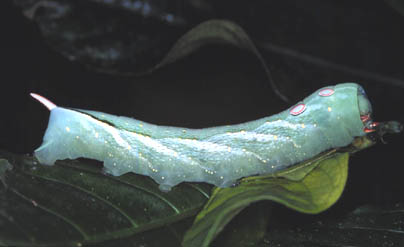
Moths emerge from pupae in 17-35 days. Larva and pupa images courtesy of Dan Janzen.
| 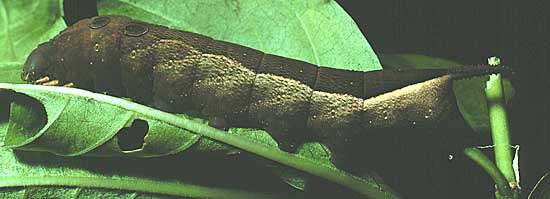 |
Larvae are subject to parasitization by Meteorus congregatus of the Braconidae family.
Use your browser "Back" button to return to the previous page.
Goto Main Sphingidae Index
Goto Macroglossini Tribe
Goto Central American Indices
Goto Carribean Islands
Goto South American Indices
Goto U.S.A. tables
 | 
Show appreciation for this site by clicking on flashing butterfly to the left.
The link will take you to a page with links to many insect sites. |










